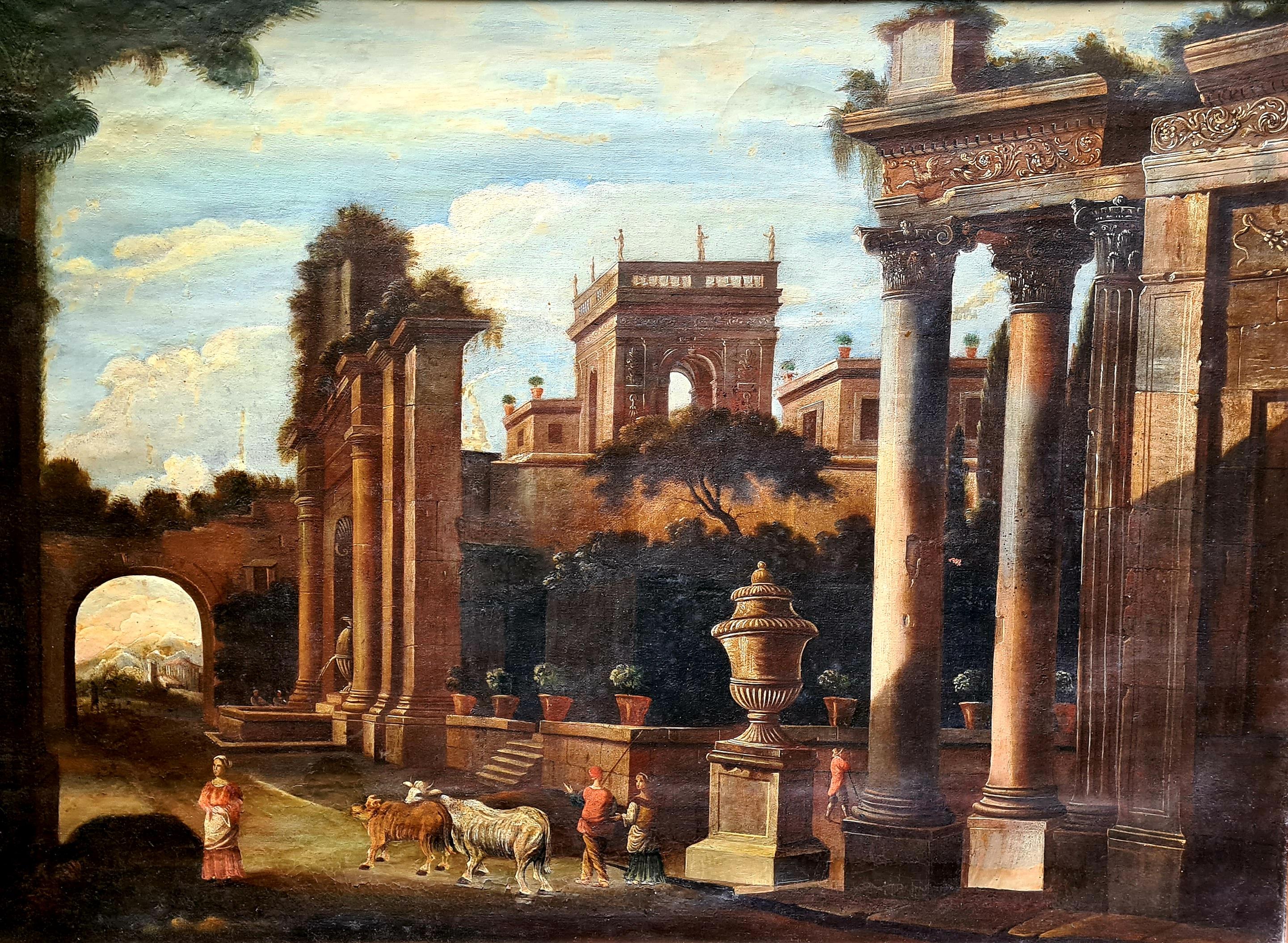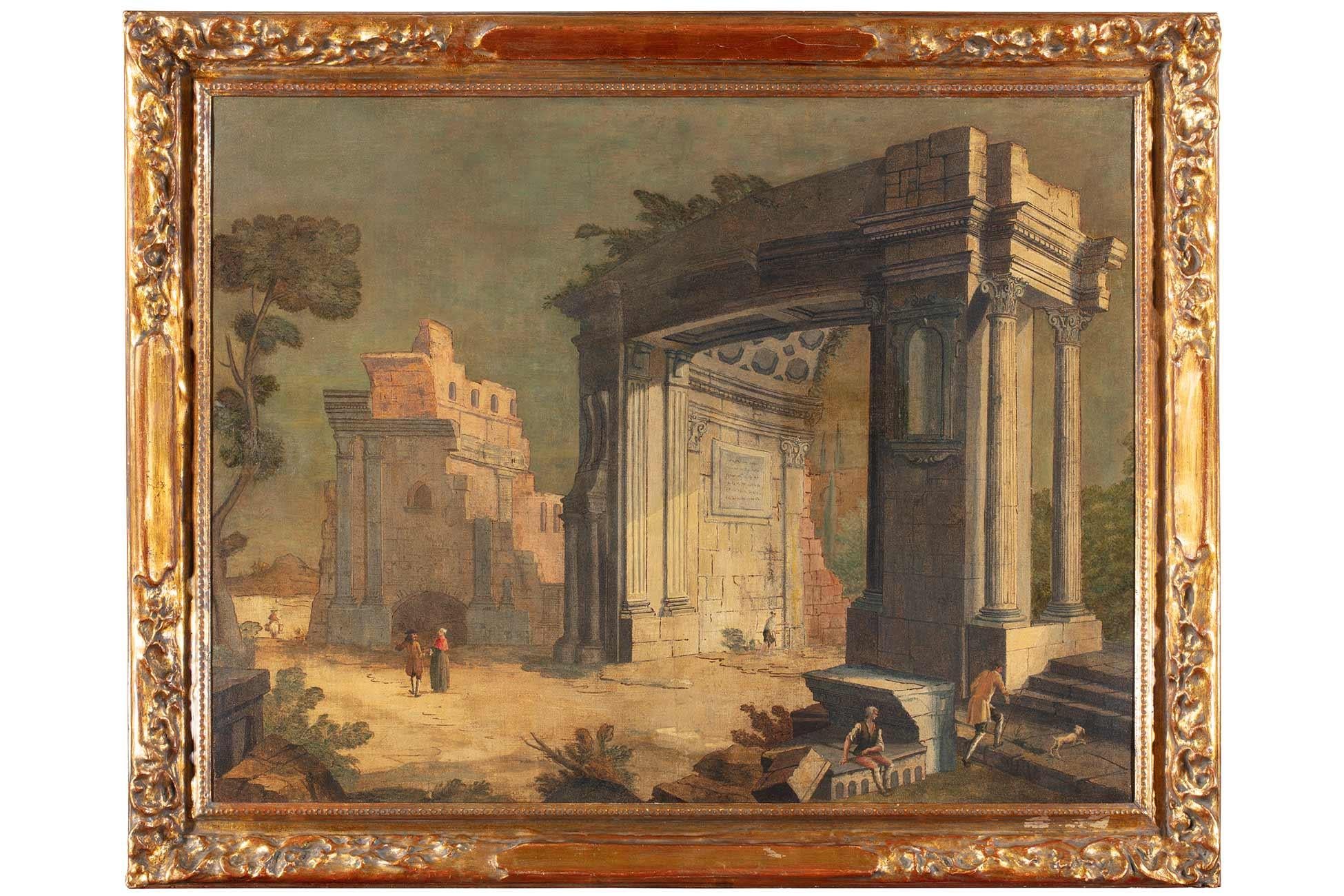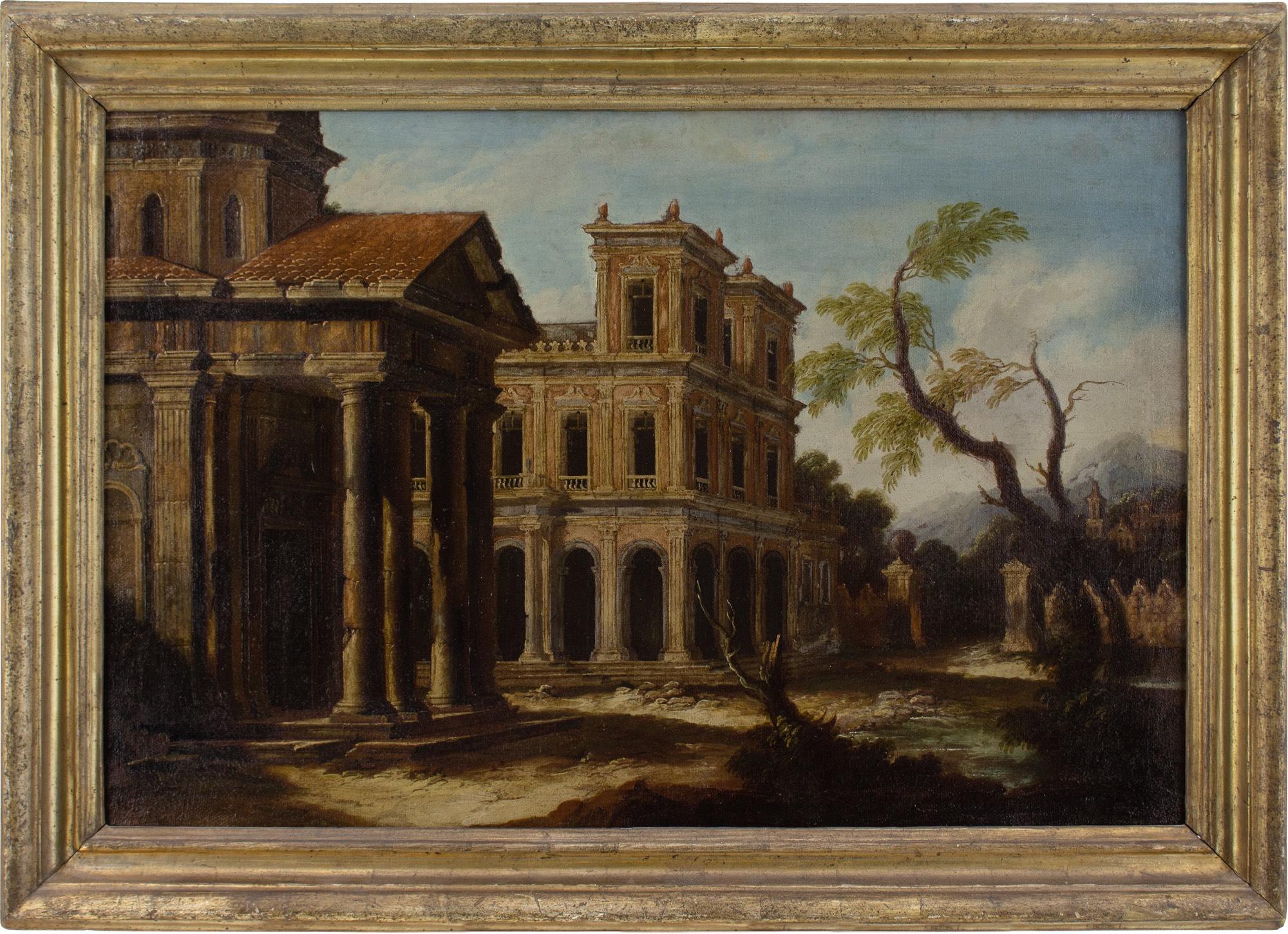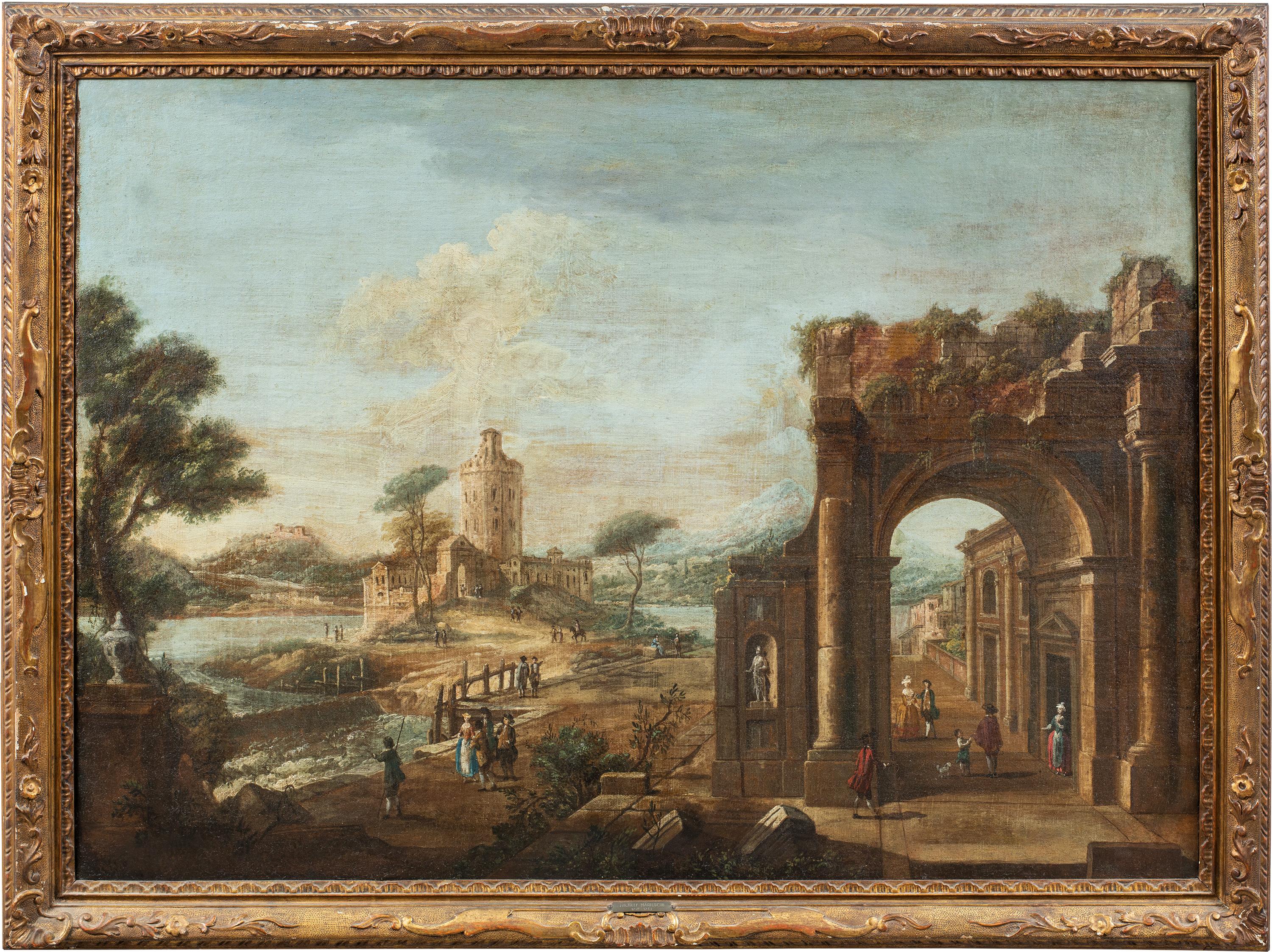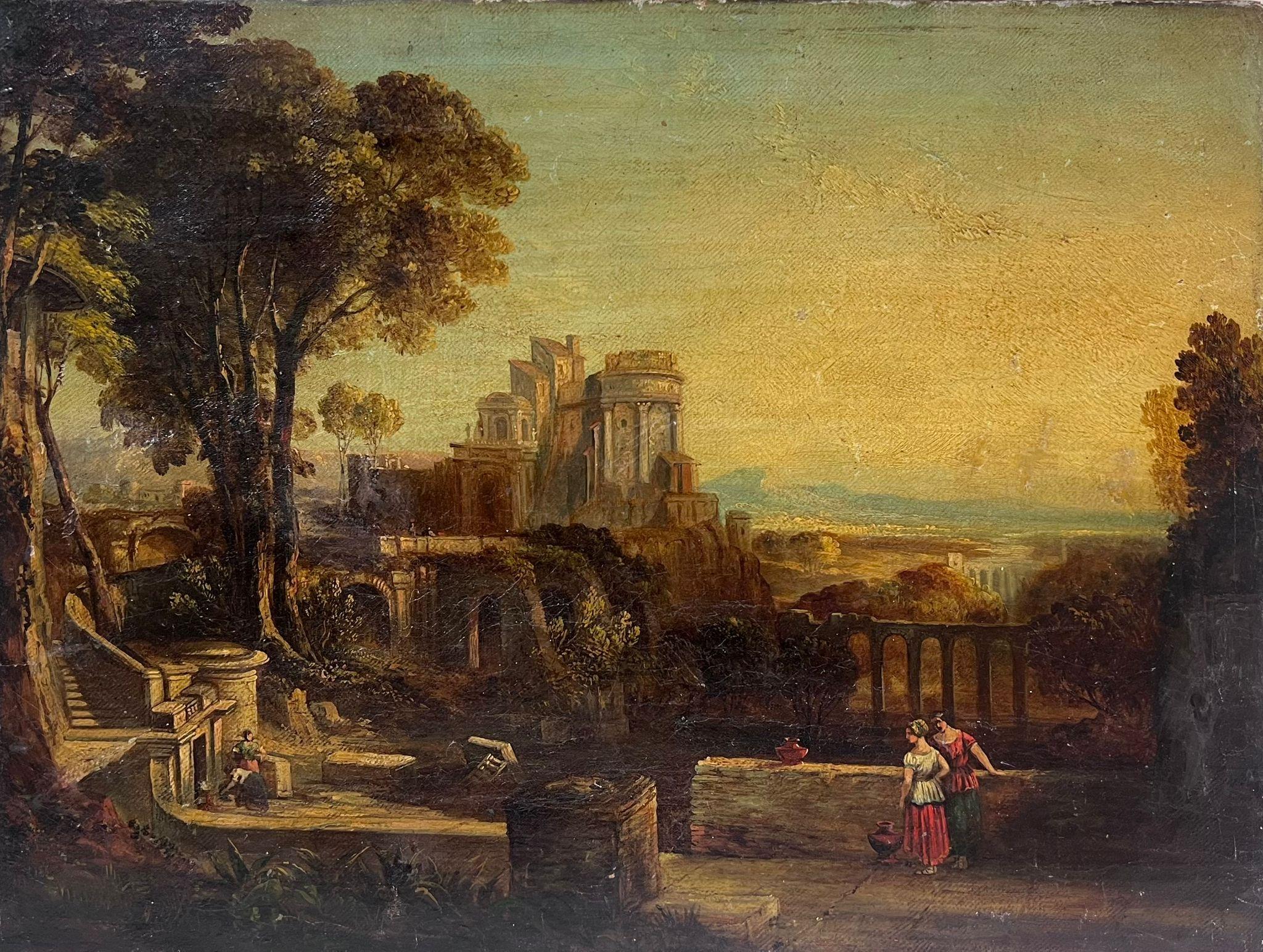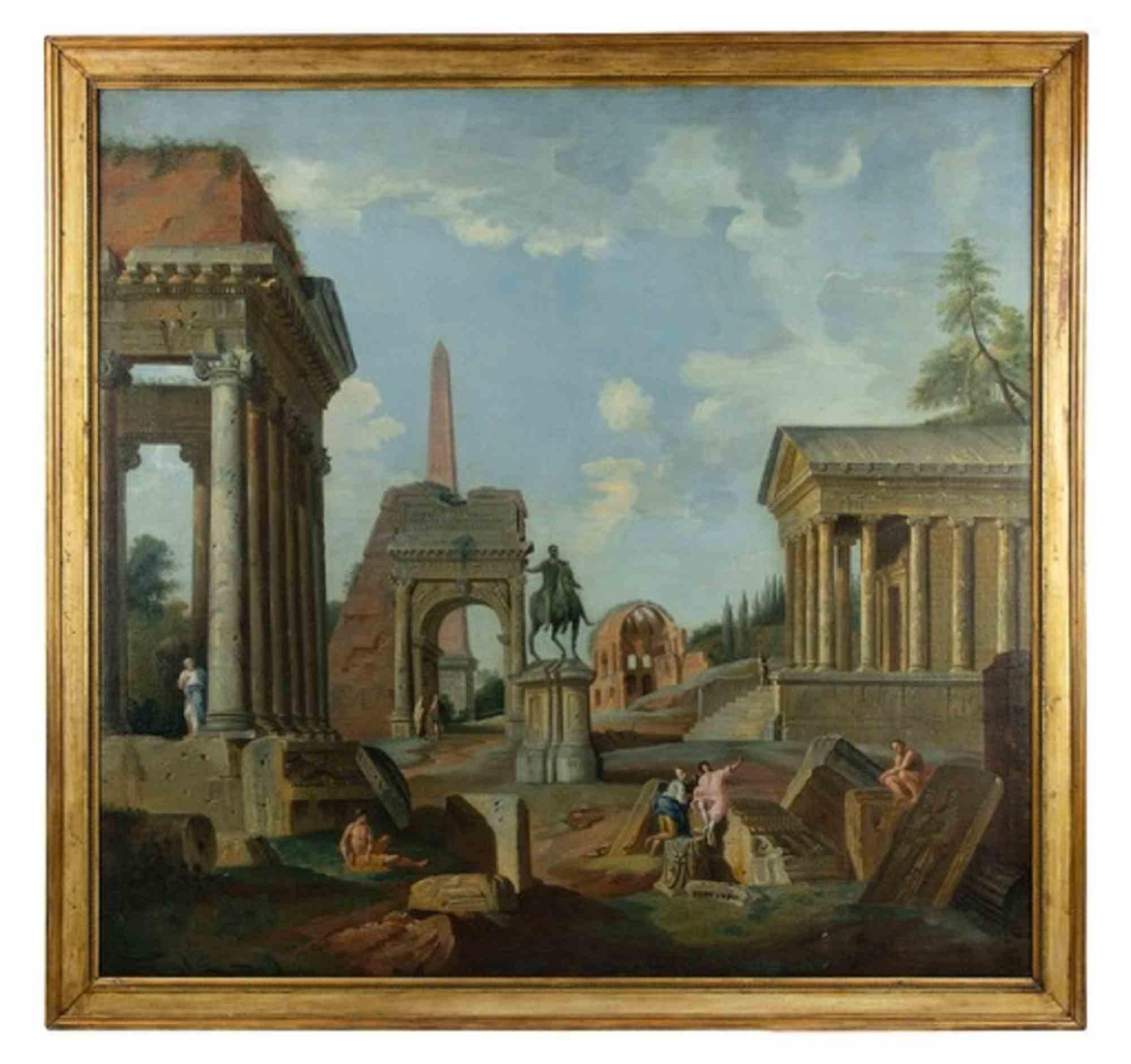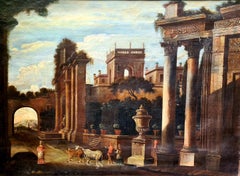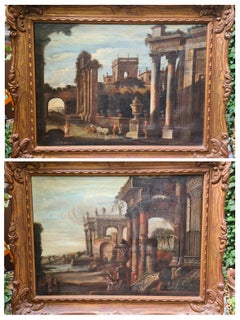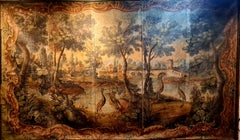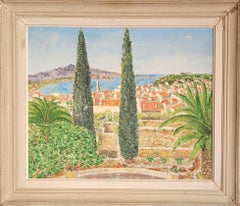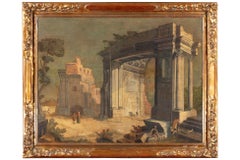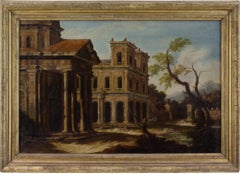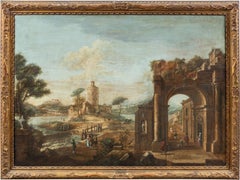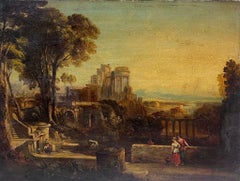Items Similar to Large Grand Tour 18th Century Capriccio Painting Roman Ruins after Gennaro Greco
Video Loading
Want more images or videos?
Request additional images or videos from the seller
1 of 17
Large Grand Tour 18th Century Capriccio Painting Roman Ruins after Gennaro Greco
$9,058.21
$11,322.7720% Off
£6,707.55
£8,384.4420% Off
€7,600
€9,50020% Off
CA$12,456.40
CA$15,570.5020% Off
A$13,854.72
A$17,318.4020% Off
CHF 7,251.26
CHF 9,064.0820% Off
MX$168,981.86
MX$211,227.3220% Off
NOK 91,114.75
NOK 113,893.4320% Off
SEK 85,705.18
SEK 107,131.4820% Off
DKK 57,861.14
DKK 72,326.4320% Off
About the Item
A fine, large 18th century veduta capriccio scene with temple ruins after Gennaro Greco from the circle of Pietro Cappelli. The painting is presented in a more modern carved gilt wood frame. This painting is one of a pair the other being also available on 1stdibs reference LU1430214395802
Provenance: A private English collection thence by descent.
This large eighteenth-century Italian oil on canvas painting is a fine example of architectural fantasy. It is a work of excellent quality. Although the decorations of ancient buildings and sculptures are imaginary, they are designed to charm rather than describe. The ruins are animated by colourful characters. The artist's ability to use perspective and the skillful rendering of building materials, such as the realistic marbles of the columns, make this painting a tour de force.
It is a magnificent large scale veduta capriccio scene with temple ruins, animals and figures socialising. Fantastic detail of statuary, idealised landscapes, costumes and of course the buildings themselves. Very much in the 'Grand Tour' style this fantastic works would have graced an important collection and will be a valuable and imposing addition to any interior or collection.
Gennaro Greco also known as "Il Mascacotta" (1663–1714) was an Italian architectural painter who was active in Naples during the late Baroque period. He is known for his architectural paintings, capricci, compositions with ruins, as well as his vedute. His vedute fall mostly in the category of the so-called vedute ideate which represent closely observed views of completely imaginary landscapes.
Pietro Capelli trained under Francesco Solimena and worked in his native Naples in the early 18th century. Mainly a painter of quadrature, he also painted landscapes. Capriccio scenes such as these, which combined architecture with landscape and genre figures, often required artists to collaborate according to their specialties, the figures and animals in this pair of scenes may have been completed by a different hand to the architectural ruins.
Pietro Capelli or Pietro Cappelli (born circa 1700, died 1724 or 1727[ was an Italian painter of the Rococo, active in his native city of Naples. He trained under Francesco Solimena. He was active in quadratura, but also painted capricci and canvases with landscapes.
He was a rival of Leonardo Coccorante. His father, Giuseppe Capelli, was a scenic designer at the Teatro San Bartolomeo in Naples. His brother, Giuseppe Cappelli (or Capelli) was a painter in Rome of scenographic decoration (theatrical decorations). Grossi states that he was so full of imagination, and fast at painting, that he did not even sketch beforehand for his works.
In painting, a capriccio is an architectural fantasy, placing together buildings, archaeological ruins and other architectural elements in fictional and often fantastical combinations. These paintings may also include staffage (figures). This style of painting was introduced in the Renaissance and continued into the Baroque.
By the late 18th century the term had expanded to mean any image with an equivalent degree of fantasy, for example as used in the titles of print series by Giovanni Battista Tiepolo and Goya, both of whom focus on figures rather than architecture.
- Dimensions:Height: 35.44 in (90 cm)Width: 45.67 in (116 cm)Depth: 3.55 in (9 cm)
- Medium:
- Movement & Style:
- Circle Of:Pietro Cappelli (1700 - 1724, Italian)
- Period:
- Condition:Extensive areas of old restoration. These paintings were restored and relined at the beginning of the 20th Century and it is from this time that the frames date.
- Gallery Location:Cotignac, FR
- Reference Number:Seller: LG/CappelliLake1stDibs: LU1430214555712
About the Seller
5.0
Platinum Seller
Premium sellers with a 4.7+ rating and 24-hour response times
Established in 2000
1stDibs seller since 2020
260 sales on 1stDibs
Typical response time: 2 hours
- ShippingRetrieving quote...Shipping from: Cotignac, France
- Return Policy
Authenticity Guarantee
In the unlikely event there’s an issue with an item’s authenticity, contact us within 1 year for a full refund. DetailsMoney-Back Guarantee
If your item is not as described, is damaged in transit, or does not arrive, contact us within 7 days for a full refund. Details24-Hour Cancellation
You have a 24-hour grace period in which to reconsider your purchase, with no questions asked.Vetted Professional Sellers
Our world-class sellers must adhere to strict standards for service and quality, maintaining the integrity of our listings.Price-Match Guarantee
If you find that a seller listed the same item for a lower price elsewhere, we’ll match it.Trusted Global Delivery
Our best-in-class carrier network provides specialized shipping options worldwide, including custom delivery.More From This Seller
View AllGrand Tour 18th Century Veduta Capriccio Painting, After Gennaro Greco
Located in Cotignac, FR
A fine, large 18th century veduta capriccio scene with temple ruins after Gennaro Greco from the circle of Pietro Cappelli. The painting is presented in a more modern carved gilt woo...
Category
18th Century Baroque Landscape Paintings
Materials
Oil, Canvas
$9,058 Sale Price
20% Off
Pair of Grand Tour 18th Century Veduta Capriccio Paintings, After Gennaro Greco
Located in Cotignac, FR
A large pair of 18th century veduta capriccio scenes with temple ruins after Gennaro Greco from the circle of Pietro Cappelli. The paintings are presented in more modern carved gilt ...
Category
18th Century Baroque Landscape Paintings
Materials
Oil, Canvas
$17,162 Sale Price
20% Off
Large French 18th Century Oil on Canvas Pastoral Scene, 'Verdure' Aubusson Style
Located in Cotignac, FR
Monumental French 18th Century oil on canvas 'Verdure' pastoral scene in the manner of the tapestries of Royal Aubusson and the style of Isaac Moillon.
Provenance: Southern French ...
Category
Early 18th Century Rococo Landscape Paintings
Materials
Canvas, Oil
The Côte d'Azur. Mid-Century Oil Landscape Painting.
Located in Cotignac, FR
Mid-century oil on board of a Mediterranean coastal scene by Janoti. Signed bottom right.
This artwork beautifully captures a sunlit Mediterranean landscape, dominated by the bold v...
Category
Mid-20th Century Landscape Paintings
Materials
Oil, Board
Rococo Pastoral Landscape, Figures, Oxen and Sheep Circle of Saverio Della Gatta
Located in Cotignac, FR
Late 18th or early 19th century oil on canvas Rococo idylic pastoral scene. Though not signed the painting is of very fine quality and is presented in a plain gilt wood frame.
This...
Category
18th Century Rococo Figurative Paintings
Materials
Canvas, Oil
Piranesi, Hand Coloured Period Engraving, Vue d'un Superb Palais de Rome
By Giovanni Battista Piranesi
Located in Cotignac, FR
A fine hand coloured 18th Century engraving after the original by Piranesi (Rome 1743), published by Danisy, Paris. Presented in period gold leaf frame, under glass.
Piranesi was born in Venice, in the parish of S. Moisè where he was baptised. His father was a stonemason. His brother Andrea introduced him to Latin literature and ancient Greco-Roman civilization, and later he was apprenticed under his uncle, Matteo Lucchesi, who was a leading architect in Magistrato delle Acque, the state organization responsible for engineering and restoring historical buildings.
From 1740, he had an opportunity to work in Rome as a draughtsman for Marco Foscarini, the Venetian ambassador of the new Pope Benedict XIV. He resided in the Palazzo Venezia and studied under Giuseppe Vasi, who introduced him to the art of etching and engraving of the city and its monuments. Giuseppe Vasi found Piranesi's talent was much greater than that of a mere engraver. According to Legrand, Vasi told Piranesi that "you are too much of a painter, my friend, to be an engraver."
After his studies with Vasi, he collaborated with pupils of the French Academy in Rome to produce a series of vedute (views) of the city; his first work was Prima parte di Architettura e Prospettive (1743), followed in 1745 by Varie Vedute di Roma Antica e Moderna.
From 1743 to 1747, he was mainly in Venice where, according to some sources, he often visited Giovanni Battista Tiepolo, a leading artist in Venice. It was Tiepolo who expanded the restrictive conventions of reproductive, topographical and antiquarian engravings. He then returned to Rome, where he opened a workshop in Via del Corso. In 1748–1774, he created an important series of vedute of the city which established his fame. In the meantime Piranesi devoted himself to the measurement of many of the ancient buildings: this led to the publication of Le Antichità Romane de' tempo della prima Repubblica e dei primi imperatori ("Roman Antiquities of the Time of the First Republic...
Category
Late 18th Century Baroque Landscape Prints
Materials
Paper, Watercolor, Ink
You May Also Like
18th Century by Antonio Stom Architectural Capriccio Oil on Canvas_
By Antonio Stom
Located in Milano, Lombardia
Antonio Stom (Venice, Italy, c. 1688 - 1734)
Title: Architectural Capriccio
Medium: Oil on canvas
Dimensions: without frame 88 x 113 cm - with frame 106 x 132 cm
Carved, sculpted and...
Category
Early 18th Century Old Masters Landscape Paintings
Materials
Canvas, Oil, Cotton Canvas
$19,069 Sale Price
28% Off
Late 17th-Century Italian School, Architectural Capriccio With Portico
Located in Cheltenham, GB
This late 17th-century Italian oil painting depicts a view with distinctive Italianate architecture including a building with an iconic portico and pediment.
Popular in mid-17th-cen...
Category
1680s Italian School Landscape Paintings
Materials
Canvas, Oil
Francesco Battaglioli (Venetian master) - 18th century painting - Ruins Landscap
By Francesco Battaglioli
Located in Varmo, IT
Francesco Battaglioli (Modena 1710 ca. - Venice post 1796) - Architectural capriccio with characters.
83.5 x 114.5 cm without frame, 98 x 130 cm...
Category
Mid-18th Century Rococo Landscape Paintings
Materials
Canvas, Oil
Fine 1800's Italian Grand Tour Oil Painting Figures before Classical Buildings
Located in Cirencester, Gloucestershire
The Arcadian View
Italian School, circa 1800
Grand Tour subject
oil on canvas, unframed
canvas : 12 x 16 inches
provenance: private collection, UK
condition: very good and sound cond...
Category
Early 1800s Old Masters Landscape Paintings
Materials
Oil
$2,116 Sale Price
30% Off
Roman Ruins - Painting attr. to Francis Harding - 17th Century
Located in Roma, IT
Roman ruins is an original old master artwork realized realized by a follower of the artist Giovanni Paolo Panini and attributed to Francis Harding (1730-1766).
Mixed colored oil on canvas.
Includes frame.
The work is a replica of Panini's canvas made around 1740, made known by Ferdinando Arisi in his 1986 monograph (Cat.456) as belonging to the Galleria Taccani in Milan and recently reappeared on the London market...
Category
17th Century Modern Figurative Paintings
Materials
Paint, Oil
A 17th c. Italian school, Capriccio with the Colosseum, circle of V. Codazzi
Located in PARIS, FR
A capriccio with the Colosseum in Roma
17th century Italian school
Circle of Viviano Codazzi (1604-1670)
Oil on canvas
Dimensions: h. 35.43 in, w. 51.18 in
Modern 17th century style ...
Category
17th Century Old Masters Landscape Paintings
Materials
Canvas, Oil
More Ways To Browse
Pair Large Paintings
Roman Ruins
18th Century English Painting
Prints Of 18th Century Paintings
18th Century Baroque Painting
English Renaissance Painting
Renaissance 18th Century Painting
18th Century Costume
Renaissance Art Pairings
Italian Ruins Painting
Italy Ruins Painting
18th Century English Oil Paintings
18th Century Italian Landscape Painting
Roman Baroque Painting
Baroque Oil Painting Large
Ancient Roman Column
Grand Tour Oil Painting
Italian Rococo Painting
